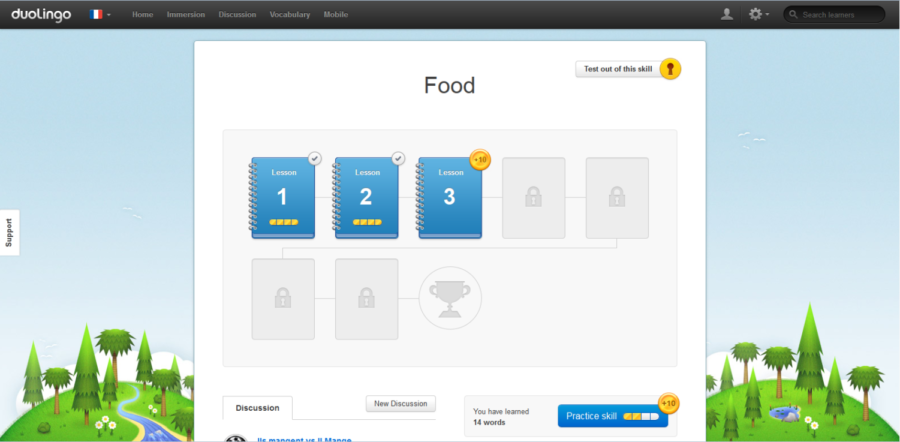The Duolingo App: Language Learning in the Modern Era
How Duolingo is being used by students at Bronx Science.
Jamesmcmahon0 at English Wikipedia, CC0, via Wikimedia Commons
Here is a screen-shot of the ‘skill tree’ for food, in the English to French version of Duolingo, an app that many students are using for language building skills.
Luis von Ahn and Severin Hacker founded the app Duolingo in 2011. Originally, the creators wanted to monetize the app by selling student translation services to companies, but they eventually decided to adopt a different approach. The pair had a dream of providing free language learning services to everyone in the world. Judging by the fact that the app has been used by 500 million people worldwide so far, they have succeeded.
What makes Duolingo effective is the unique approach it takes to language learning. In school, students are taught the rules of the language and build from there. Duolingo instead uses “implicit learning,” where users are able to infer the rules on their own. This method attempts to mimic how children learn their first language.
The app uses a technique called “gamification.” The idea is that students learn better when they are interested in a topic, so by making learning into a game, the students are more invested in their learning. According to Mr. Jep Jonson, a Special Education teacher at Bronx Science, “gamification has enough research validity that it is going to become more prevalent in education. With the Duolingo model in particular, I would love to see how it could be applied to math.”
Some companies have attempted to recreate the magic of Duolingo with math. DragonBox, a Norwegian company with a focus in educational apps, released DragonBox Algebra and DragonBox Elements, designed to teach students basic algebra and geometry, respectively.
Gamification was around for a long time before Duolingo, however.
Duolingo’s use of gamification appears to be to its advantage. In an efficacy study comparing university students and Duolingo users, the researchers found that “Learners who finished the beginning section of the Duolingo Spanish or French course… were comparable with the proficiency outcomes of university students at the end of fourth semester in language programs, but with Duolingo learners spending only half the amount of time.”
Many Bronx Science students currently use Duolingo as an aide in studying for their World Languages classes at school. Claire Garbowski ’22 took Duolingo’s French course to supplement her regular classes. “I feel like it’s better as a study tool versus a sole learning source,” she said. By combining the baseline knowledge from Duolingo’s French course with the specific instruction of a classroom setting, she was able to excel.
Similarly, Nusaiba Afran ’24 used the app while in quarantine during the COVID-19 pandemic to help her learn Spanish.
The common opinion among most students and teachers is that Duolingo is best used as a supplement, but it needs to be aided by something more. When learning Italian, Mr. Jonson was able to talk with his wife, a native speaker, in order to improve his conversational skills. “I like Duolingo, and it’s very good for some things, but one thing it’s not very good at is for conversations. For doing that, you really need someone who speaks the language, with whom to converse.”
Reasons for learning a language can vary wildly. Cole Megaw ’24 is currently taking Duolingo’s Esperanto and Latin courses: “I think constructed languages are very interesting, and also the fact that it’s an auxiliary language is very appealing to me…I find Latin to be fascinating; it’s very good to know, because it’s where romance languages come from, and it is also the origin of most European languages.”
Language is also tied to culture, and the ways they intersect vary between different ethnic groups. Brian Tong ‘22 spoke candidly about his experiences with Chinese:
“It’s a common thing for Chinese-Americans that their Chinese won’t be very good, and native speakers will comment on that, which is something I don’t love. I was always curious about Chinese culture and cuisine, but whenever I would go to an authentic Chinese restaurant and order, they’d say, ‘Oh, you’re born here right?’ I mean why would you say that?”
“Even now, I only really speak Mandarin Chinese. My dad’s side speaks Cantonese, another dialect of Chinese, and I’m not really able to talk with them. I’ve spoken Mandarin my entire life, and I’ve been able to communicate with my mom’s side of the family, and be with them and have experiences with them. With my dad’s side, however, I usually have my dad translate the Cantonese, and it makes it more…inconvenient to talk to them. It doesn’t flow as well, and you just can’t talk as much when communicating takes so long.”
Culture and language are, in some ways, inseparable. However, differences can be overcome in different ways. “For me, food is one of the important things of keeping track of other cultures. When I was in Italy, I picked up a cookbook and a sourdough bread book in Italian,” said Mr. Jonson.
Since its creation, Duolingo has effectively helped millions in building up one of the most important skills in the modern world.
What makes Duolingo effective is the unique approach it takes to language learning.
Tzvi Kalb is an Editorial Editor for 'The Science Survey.' For Tzvi, journalistic writing gives him incredible freedom to write on important issues and...

